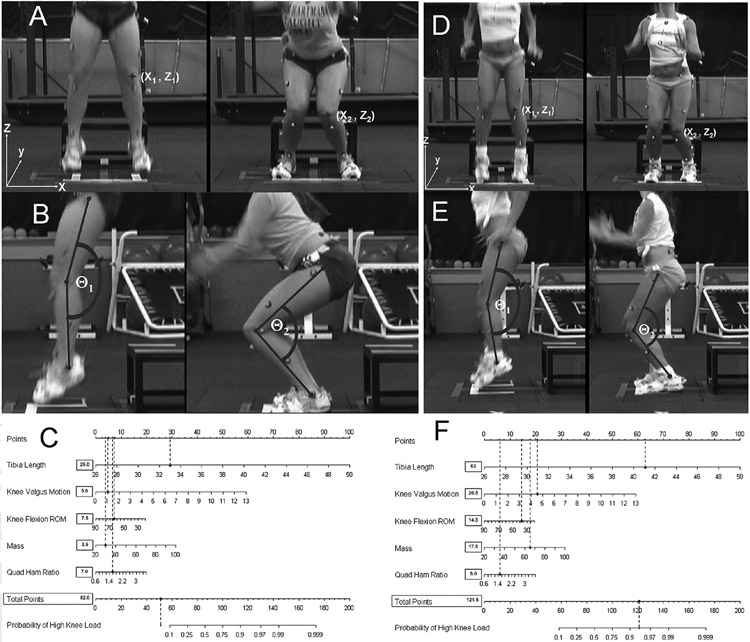Figure 4.
A) Subject whose combination of decreased tibia length and mass prior to her rapid growth spurt diminish risk to demonstrate high knee abduction moment (KAM) landing mechanics. Knee valgus motion during the drop-vertical jump is calculated as the displacement measure between the 2 marked knee alignments in the X plane measured at the frame prior to initial contact and the frame with maximum knee flexion (X2−X1). B) Knee flexion range of motion (ROM) during the drop-vertical jump is calculated as the difference in knee flexion angle between initial contact and maximum knee flexion positions (Θ1−Θ2). C) Completed nomogram for the representative subject (tibia length, 32.5 cm; knee valgus motion, 4.2 cm; knee flexion ROM, 74.1°; mass, 30.7 kg; QuadHam, 1.64). Based on her demonstrated measurements, this subject would have a 12% (62.5 points) chance to demonstrate high KAM during the drop-vertical jump. Her actual KAM measure for the presented drop-vertical jump that was quantified simultaneously with 3-dimensional motion analysis was 13.4 Nm of knee abduction load. D) Subject whose combination of increased tibia length and mass, associated with her rapid growth, contribute to her increased risk to demonstrate high KAM landing mechanics when using the clinic-based ACL injury risk prediction algorithm. Knee valgus motion during the drop-vertical jump is calculated (X2−X1). E) Knee flexion ROM during the drop-vertical jump is calculated (Θ1−Θ2). F) Completed nomogram for the representative subject (tibia length, 45 cm; knee valgus motion, 3.0 cm; knee flexion ROM, 60.0°; mass, 71 kg; QuadHam, 1.19). Based on her demonstrated measurements, this subject would have a 91% (116.5 points) chance to demonstrate high KAM during the drop-vertical jump. Her actual KAM measure for the presented drop-vertical jump that was quantified simultaneously with 3-dimensional motion analysis was 48.5 Nm of knee abduction load.

